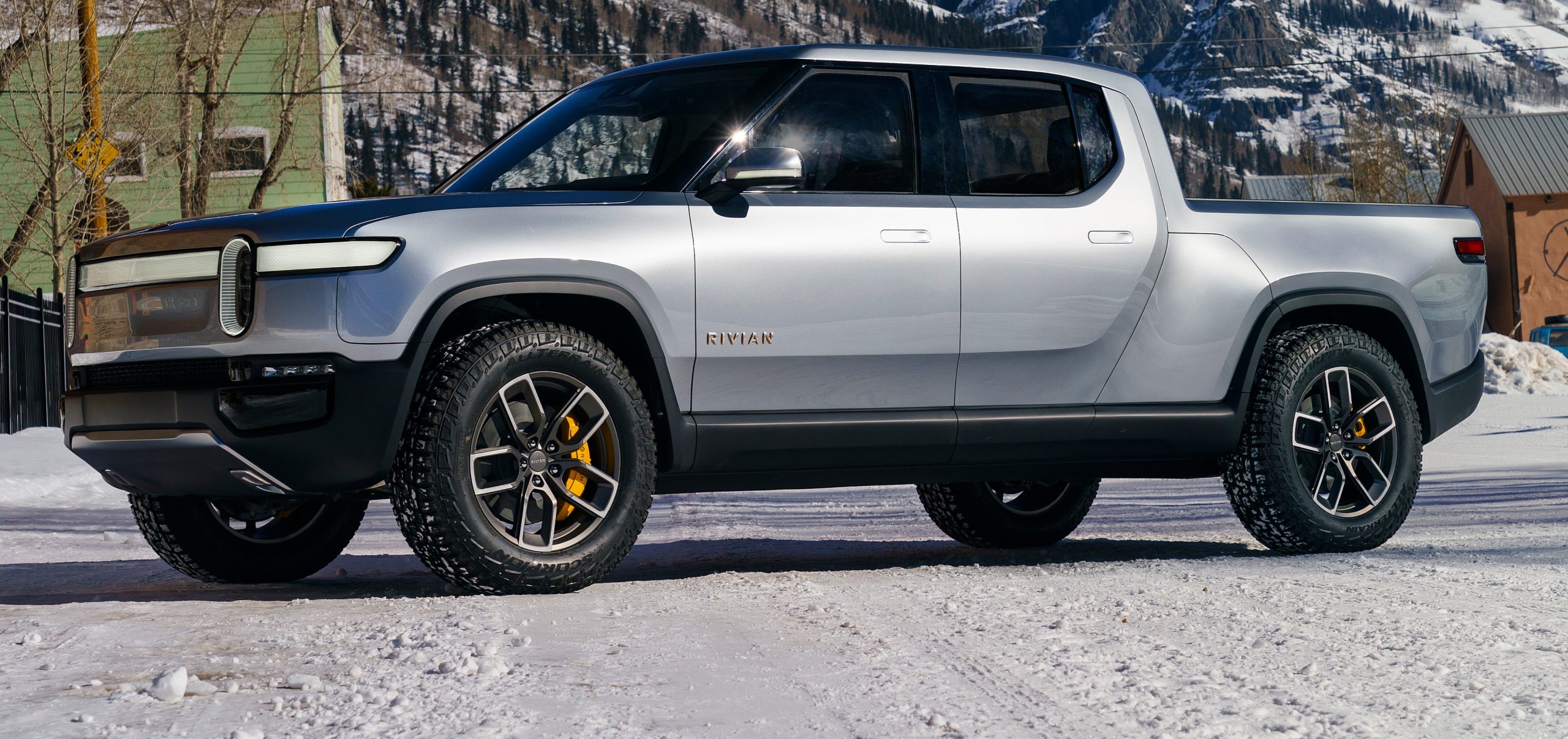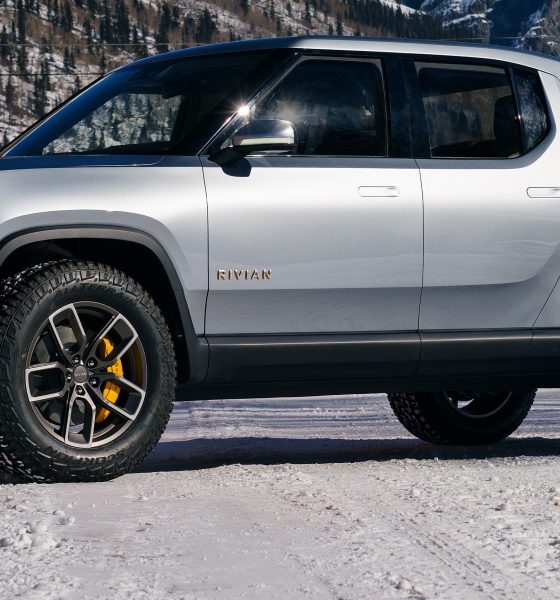

News
Rivian R1T pickup truck will be a viable commercial fleet vehicle, analysts weigh in
Rivian has branded itself as a luxury electric vehicle-maker for outdoor enthusiasts, but auto industry analysts have recently seen another promising use for the company’s upcoming products: fleet vehicles.
The R1T has over 800 lb-ft of torque, nearly 1800 lbs of payload capacity, and the ability to tow around 11,000 lbs, making it a vehicle capable of serious work in nearly any industry currently utilizing trucks for business purposes in company fleets.
However, even Rivian’s largest battery pack, which boasts an impressive 400 miles of range, doesn’t quite meet the range expectations that truck customers expect from their gasoline and diesel-powered vehicles. This particular customer base, of course, isn’t Rivian’s immediate target as it first enters the market, but the Michigan-based car maker is already piquing broad interest in its vehicles, and industry professionals are taking note.

Not every potential Rivian truck customer will see limited mileage as a reason to choose diesel-power over battery-electric power, as predicted by some auto experts assessing the company’s market appeal. Companies whose travel needs are limited to short trips to job sites, for example, could put things like torque, load capacity, and fuel savings higher on the list of priorities than range for commuting. These are areas where Rivian’s R1T shines.
“EV pickups may best be suited for commercial fleets, such as those owned by energy companies,” Michelle Krebs, executive analyst for Autotrader, was quoted as saying by the Detroit Free Press (DFP). “Fleets operating in clearly defined areas, such as metro Detroit, could be ideal. Short distances and a good charging infrastructure might also make EV pickups practical for construction and mining companies.”

Pickup trucks make up the largest part of the vehicle market in the United States, accounting for nearly 3 million sales last year, meaning that a startup like Rivian has a lot to gain if it’s able to tap into the consumer base in a meaningful way. Amazon and Ford appear to have already seen the potential in Rivian’s electric skateboard platform via their combined $1.2 billion dollars investment in the company. Jeff Bezos, CEO of Amazon, recently commented about Rivian’s mission and voiced his support for the company.
“As with most of our major investments, and acquisitions, we’re always looking for mission-driven entrepreneurs — missionaries instead of mercenaries. And the guy who leads the company, a guy named R.J., is one of the most missionary entrepreneurs I’ve ever met,” Bezos said, referring to Rivian’s CEO R.J. Scaringe.
These kinds of positive assessments for all-electric trucks in the auto market would also carry over into Tesla’s future prospects as well for its truck. Admittedly, details surrounding the Blade Runner-inspired vehicle are sparse; however, CEO Elon Musk has mentioned possible stats that would offer incredible worksite capabilities. As teased, the Tesla Truck will have 400-500 miles of range per charge, dual motor AWD, a 240-volt connection for heavy-duty tools, and up to 300,000 pounds of towing capacity. The unveiling is said to take place later this year.
Both of Rivian’s vehicles – the R1T truck and the R1S SUV – are currently open for pre-order via the company’s website. Production and deliveries are anticipated to begin in 2020.

Elon Musk
Starlink passes 9 million active customers just weeks after hitting 8 million
The milestone highlights the accelerating growth of Starlink, which has now been adding over 20,000 new users per day.

SpaceX’s Starlink satellite internet service has continued its rapid global expansion, surpassing 9 million active customers just weeks after crossing the 8 million mark.
The milestone highlights the accelerating growth of Starlink, which has now been adding over 20,000 new users per day.
9 million customers
In a post on X, SpaceX stated that Starlink now serves over 9 million active users across 155 countries, territories, and markets. The company reached 8 million customers in early November, meaning it added roughly 1 million subscribers in under seven weeks, or about 21,275 new users on average per day.
“Starlink is connecting more than 9M active customers with high-speed internet across 155 countries, territories, and many other markets,” Starlink wrote in a post on its official X account. SpaceX President Gwynne Shotwell also celebrated the milestone on X. “A huge thank you to all of our customers and congrats to the Starlink team for such an incredible product,” she wrote.
That growth rate reflects both rising demand for broadband in underserved regions and Starlink’s expanding satellite constellation, which now includes more than 9,000 low-Earth-orbit satellites designed to deliver high-speed, low-latency internet worldwide.
Starlink’s momentum
Starlink’s momentum has been building up. SpaceX reported 4.6 million Starlink customers in December 2024, followed by 7 million by August 2025, and 8 million customers in November. Independent data also suggests Starlink usage is rising sharply, with Cloudflare reporting that global web traffic from Starlink users more than doubled in 2025, as noted in an Insider report.
Starlink’s momentum is increasingly tied to SpaceX’s broader financial outlook. Elon Musk has said the satellite network is “by far” the company’s largest revenue driver, and reports suggest SpaceX may be positioning itself for an initial public offering as soon as next year, with valuations estimated as high as $1.5 trillion. Musk has also suggested in the past that Starlink could have its own IPO in the future.
News
NVIDIA Director of Robotics: Tesla FSD v14 is the first AI to pass the “Physical Turing Test”
After testing FSD v14, Fan stated that his experience with FSD felt magical at first, but it soon started to feel like a routine.

NVIDIA Director of Robotics Jim Fan has praised Tesla’s Full Self-Driving (Supervised) v14 as the first AI to pass what he described as a “Physical Turing Test.”
After testing FSD v14, Fan stated that his experience with FSD felt magical at first, but it soon started to feel like a routine. And just like smartphones today, removing it now would “actively hurt.”
Jim Fan’s hands-on FSD v14 impressions
Fan, a leading researcher in embodied AI who is currently solving Physical AI at NVIDIA and spearheading the company’s Project GR00T initiative, noted that he actually was late to the Tesla game. He was, however, one of the first to try out FSD v14.
“I was very late to own a Tesla but among the earliest to try out FSD v14. It’s perhaps the first time I experience an AI that passes the Physical Turing Test: after a long day at work, you press a button, lay back, and couldn’t tell if a neural net or a human drove you home,” Fan wrote in a post on X.
Fan added: “Despite knowing exactly how robot learning works, I still find it magical watching the steering wheel turn by itself. First it feels surreal, next it becomes routine. Then, like the smartphone, taking it away actively hurts. This is how humanity gets rewired and glued to god-like technologies.”
The Physical Turing Test
The original Turing Test was conceived by Alan Turing in 1950, and it was aimed at determining if a machine could exhibit behavior that is equivalent to or indistinguishable from a human. By focusing on text-based conversations, the original Turing Test set a high bar for natural language processing and machine learning.
This test has been passed by today’s large language models. However, the capability to converse in a humanlike manner is a completely different challenge from performing real-world problem-solving or physical interactions. Thus, Fan introduced the Physical Turing Test, which challenges AI systems to demonstrate intelligence through physical actions.
Based on Fan’s comments, Tesla has demonstrated these intelligent physical actions with FSD v14. Elon Musk agreed with the NVIDIA executive, stating in a post on X that with FSD v14, “you can sense the sentience maturing.” Musk also praised Tesla AI, calling it the best “real-world AI” today.
News
Tesla AI team burns the Christmas midnight oil by releasing FSD v14.2.2.1
The update was released just a day after FSD v14.2.2 started rolling out to customers.

Tesla is burning the midnight oil this Christmas, with the Tesla AI team quietly rolling out Full Self-Driving (Supervised) v14.2.2.1 just a day after FSD v14.2.2 started rolling out to customers.
Tesla owner shares insights on FSD v14.2.2.1
Longtime Tesla owner and FSD tester @BLKMDL3 shared some insights following several drives with FSD v14.2.2.1 in rainy Los Angeles conditions with standing water and faded lane lines. He reported zero steering hesitation or stutter, confident lane changes, and maneuvers executed with precision that evoked the performance of Tesla’s driverless Robotaxis in Austin.
Parking performance impressed, with most spots nailed perfectly, including tight, sharp turns, in single attempts without shaky steering. One minor offset happened only due to another vehicle that was parked over the line, which FSD accommodated by a few extra inches. In rain that typically erases road markings, FSD visualized lanes and turn lines better than humans, positioning itself flawlessly when entering new streets as well.
“Took it up a dark, wet, and twisty canyon road up and down the hill tonight and it went very well as to be expected. Stayed centered in the lane, kept speed well and gives a confidence inspiring steering feel where it handles these curvy roads better than the majority of human drivers,” the Tesla owner wrote in a post on X.
Tesla’s FSD v14.2.2 update
Just a day before FSD v14.2.2.1’s release, Tesla rolled out FSD v14.2.2, which was focused on smoother real-world performance, better obstacle awareness, and precise end-of-trip routing. According to the update’s release notes, FSD v14.2.2 upgrades the vision encoder neural network with higher resolution features, enhancing detection of emergency vehicles, road obstacles, and human gestures.
New Arrival Options also allowed users to select preferred drop-off styles, such as Parking Lot, Street, Driveway, Parking Garage, or Curbside, with the navigation pin automatically adjusting to the ideal spot. Other refinements include pulling over for emergency vehicles, real-time vision-based detours for blocked roads, improved gate and debris handling, and Speed Profiles for customized driving styles.








